Managing Ageing Workforce in Construction Industry
VerifiedAdded on 2023/03/31
|19
|4386
|387
AI Summary
This report focuses on managing the issue of ageing workforce in the construction industry. It discusses the impact of workforce ageing, issues faced by the industry, and strategies for managing ageing workforce.
Contribute Materials
Your contribution can guide someone’s learning journey. Share your
documents today.
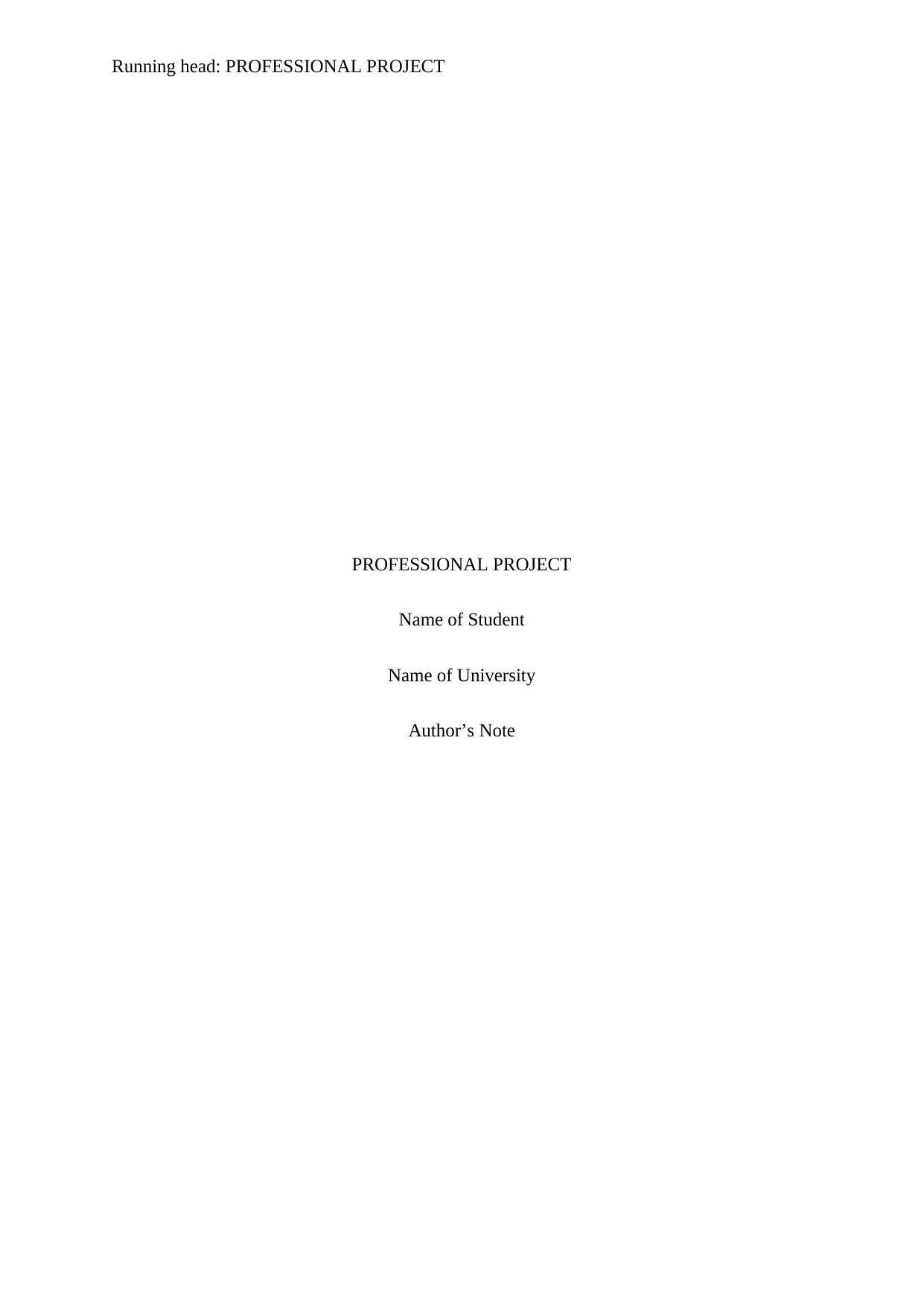
Running head: PROFESSIONAL PROJECT
PROFESSIONAL PROJECT
Name of Student
Name of University
Author’s Note
PROFESSIONAL PROJECT
Name of Student
Name of University
Author’s Note
Secure Best Marks with AI Grader
Need help grading? Try our AI Grader for instant feedback on your assignments.
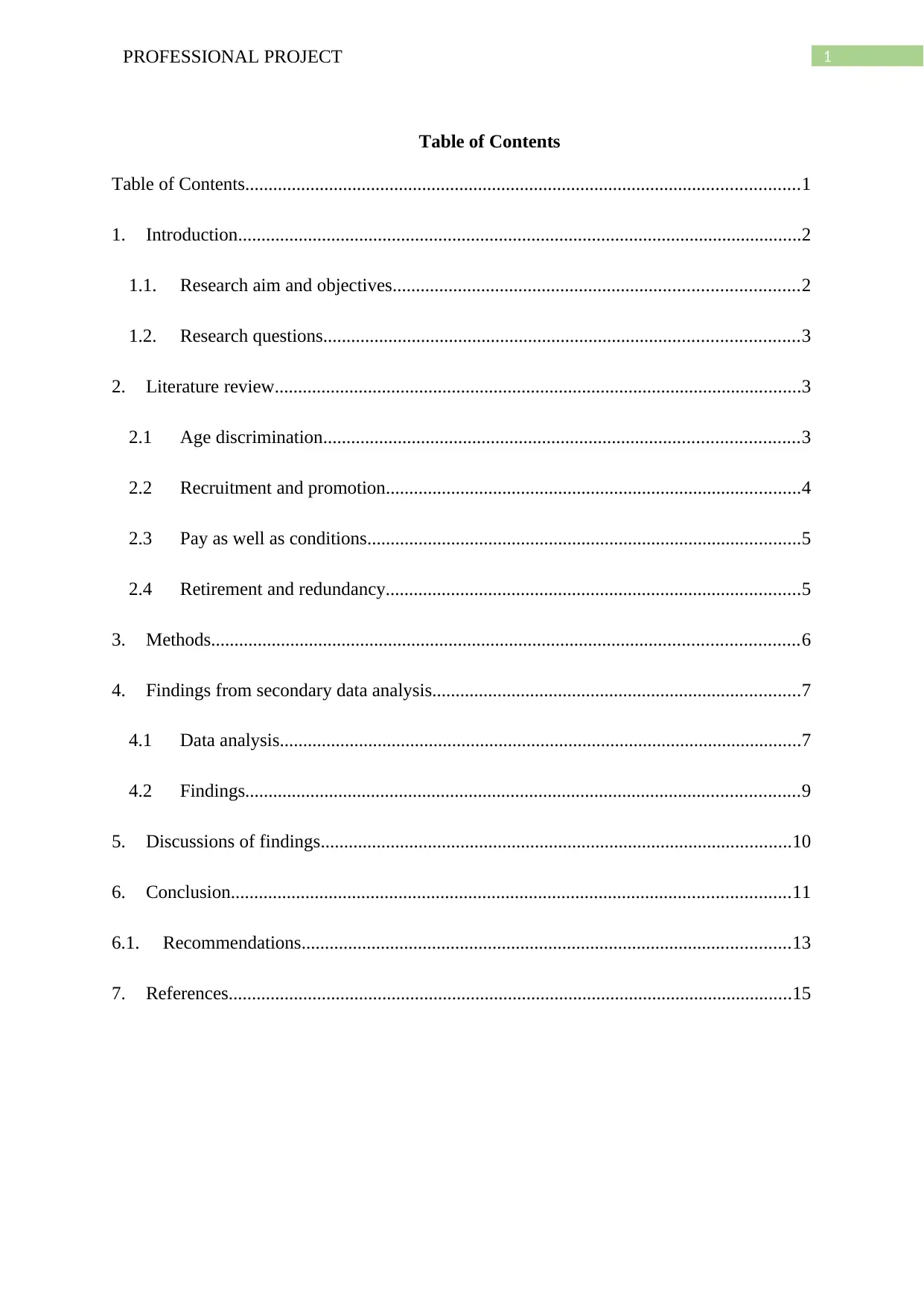
1PROFESSIONAL PROJECT
Table of Contents
Table of Contents.......................................................................................................................1
1. Introduction.........................................................................................................................2
1.1. Research aim and objectives.......................................................................................2
1.2. Research questions......................................................................................................3
2. Literature review.................................................................................................................3
2.1 Age discrimination......................................................................................................3
2.2 Recruitment and promotion.........................................................................................4
2.3 Pay as well as conditions.............................................................................................5
2.4 Retirement and redundancy.........................................................................................5
3. Methods..............................................................................................................................6
4. Findings from secondary data analysis...............................................................................7
4.1 Data analysis................................................................................................................7
4.2 Findings.......................................................................................................................9
5. Discussions of findings.....................................................................................................10
6. Conclusion........................................................................................................................11
6.1. Recommendations.........................................................................................................13
7. References.........................................................................................................................15
Table of Contents
Table of Contents.......................................................................................................................1
1. Introduction.........................................................................................................................2
1.1. Research aim and objectives.......................................................................................2
1.2. Research questions......................................................................................................3
2. Literature review.................................................................................................................3
2.1 Age discrimination......................................................................................................3
2.2 Recruitment and promotion.........................................................................................4
2.3 Pay as well as conditions.............................................................................................5
2.4 Retirement and redundancy.........................................................................................5
3. Methods..............................................................................................................................6
4. Findings from secondary data analysis...............................................................................7
4.1 Data analysis................................................................................................................7
4.2 Findings.......................................................................................................................9
5. Discussions of findings.....................................................................................................10
6. Conclusion........................................................................................................................11
6.1. Recommendations.........................................................................................................13
7. References.........................................................................................................................15
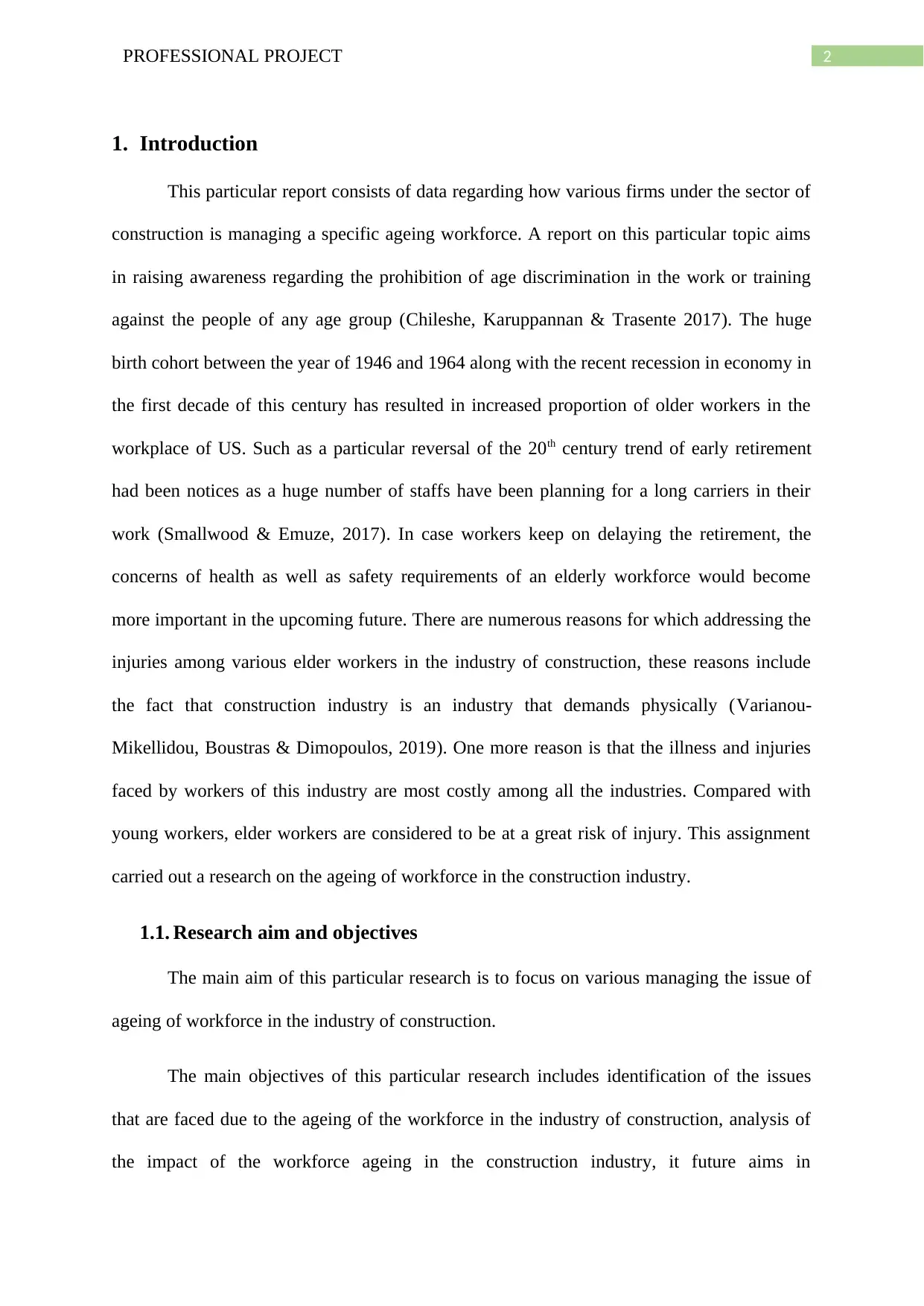
2PROFESSIONAL PROJECT
1. Introduction
This particular report consists of data regarding how various firms under the sector of
construction is managing a specific ageing workforce. A report on this particular topic aims
in raising awareness regarding the prohibition of age discrimination in the work or training
against the people of any age group (Chileshe, Karuppannan & Trasente 2017). The huge
birth cohort between the year of 1946 and 1964 along with the recent recession in economy in
the first decade of this century has resulted in increased proportion of older workers in the
workplace of US. Such as a particular reversal of the 20th century trend of early retirement
had been notices as a huge number of staffs have been planning for a long carriers in their
work (Smallwood & Emuze, 2017). In case workers keep on delaying the retirement, the
concerns of health as well as safety requirements of an elderly workforce would become
more important in the upcoming future. There are numerous reasons for which addressing the
injuries among various elder workers in the industry of construction, these reasons include
the fact that construction industry is an industry that demands physically (Varianou-
Mikellidou, Boustras & Dimopoulos, 2019). One more reason is that the illness and injuries
faced by workers of this industry are most costly among all the industries. Compared with
young workers, elder workers are considered to be at a great risk of injury. This assignment
carried out a research on the ageing of workforce in the construction industry.
1.1. Research aim and objectives
The main aim of this particular research is to focus on various managing the issue of
ageing of workforce in the industry of construction.
The main objectives of this particular research includes identification of the issues
that are faced due to the ageing of the workforce in the industry of construction, analysis of
the impact of the workforce ageing in the construction industry, it future aims in
1. Introduction
This particular report consists of data regarding how various firms under the sector of
construction is managing a specific ageing workforce. A report on this particular topic aims
in raising awareness regarding the prohibition of age discrimination in the work or training
against the people of any age group (Chileshe, Karuppannan & Trasente 2017). The huge
birth cohort between the year of 1946 and 1964 along with the recent recession in economy in
the first decade of this century has resulted in increased proportion of older workers in the
workplace of US. Such as a particular reversal of the 20th century trend of early retirement
had been notices as a huge number of staffs have been planning for a long carriers in their
work (Smallwood & Emuze, 2017). In case workers keep on delaying the retirement, the
concerns of health as well as safety requirements of an elderly workforce would become
more important in the upcoming future. There are numerous reasons for which addressing the
injuries among various elder workers in the industry of construction, these reasons include
the fact that construction industry is an industry that demands physically (Varianou-
Mikellidou, Boustras & Dimopoulos, 2019). One more reason is that the illness and injuries
faced by workers of this industry are most costly among all the industries. Compared with
young workers, elder workers are considered to be at a great risk of injury. This assignment
carried out a research on the ageing of workforce in the construction industry.
1.1. Research aim and objectives
The main aim of this particular research is to focus on various managing the issue of
ageing of workforce in the industry of construction.
The main objectives of this particular research includes identification of the issues
that are faced due to the ageing of the workforce in the industry of construction, analysis of
the impact of the workforce ageing in the construction industry, it future aims in
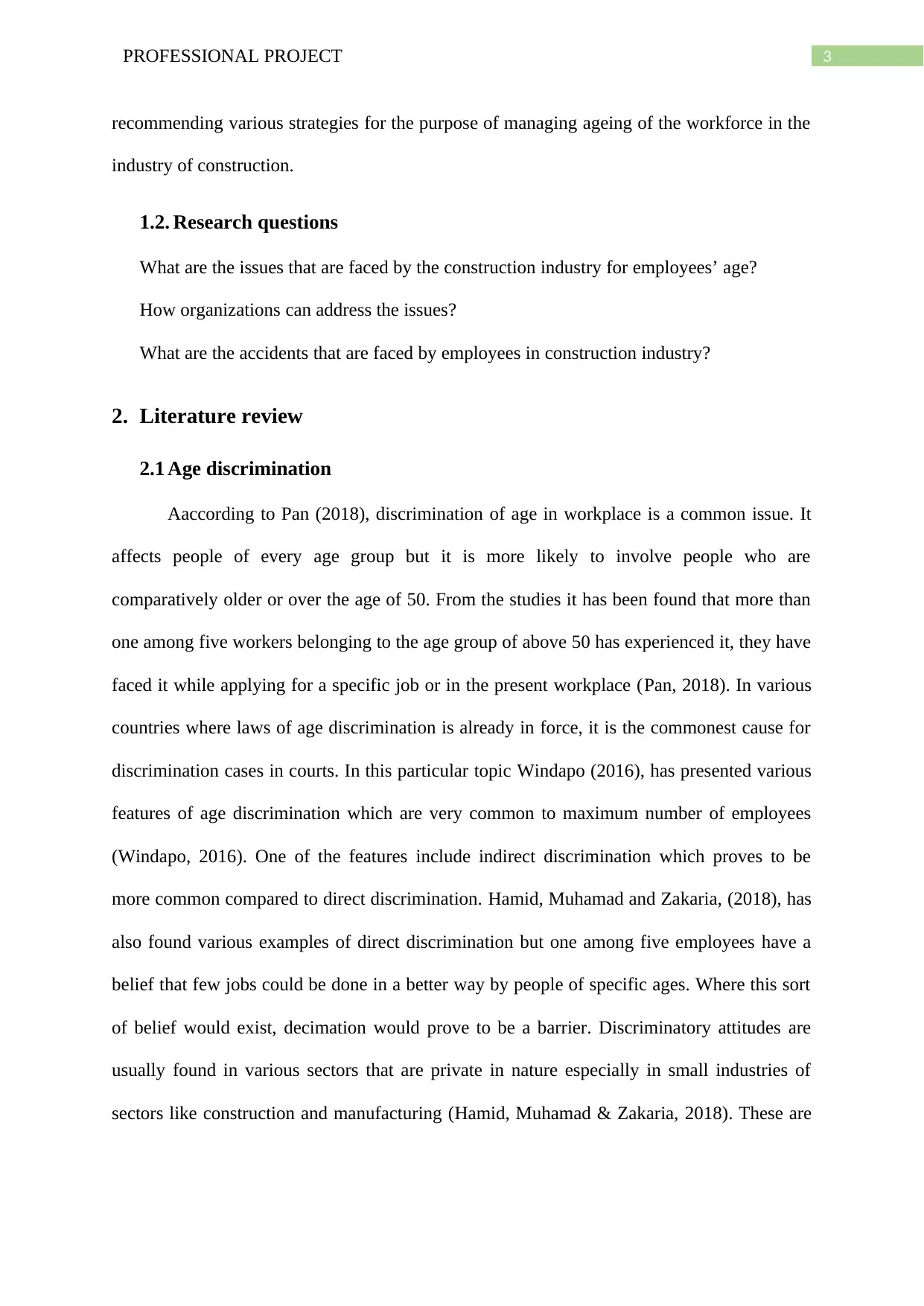
3PROFESSIONAL PROJECT
recommending various strategies for the purpose of managing ageing of the workforce in the
industry of construction.
1.2. Research questions
What are the issues that are faced by the construction industry for employees’ age?
How organizations can address the issues?
What are the accidents that are faced by employees in construction industry?
2. Literature review
2.1 Age discrimination
Aaccording to Pan (2018), discrimination of age in workplace is a common issue. It
affects people of every age group but it is more likely to involve people who are
comparatively older or over the age of 50. From the studies it has been found that more than
one among five workers belonging to the age group of above 50 has experienced it, they have
faced it while applying for a specific job or in the present workplace (Pan, 2018). In various
countries where laws of age discrimination is already in force, it is the commonest cause for
discrimination cases in courts. In this particular topic Windapo (2016), has presented various
features of age discrimination which are very common to maximum number of employees
(Windapo, 2016). One of the features include indirect discrimination which proves to be
more common compared to direct discrimination. Hamid, Muhamad and Zakaria, (2018), has
also found various examples of direct discrimination but one among five employees have a
belief that few jobs could be done in a better way by people of specific ages. Where this sort
of belief would exist, decimation would prove to be a barrier. Discriminatory attitudes are
usually found in various sectors that are private in nature especially in small industries of
sectors like construction and manufacturing (Hamid, Muhamad & Zakaria, 2018). These are
recommending various strategies for the purpose of managing ageing of the workforce in the
industry of construction.
1.2. Research questions
What are the issues that are faced by the construction industry for employees’ age?
How organizations can address the issues?
What are the accidents that are faced by employees in construction industry?
2. Literature review
2.1 Age discrimination
Aaccording to Pan (2018), discrimination of age in workplace is a common issue. It
affects people of every age group but it is more likely to involve people who are
comparatively older or over the age of 50. From the studies it has been found that more than
one among five workers belonging to the age group of above 50 has experienced it, they have
faced it while applying for a specific job or in the present workplace (Pan, 2018). In various
countries where laws of age discrimination is already in force, it is the commonest cause for
discrimination cases in courts. In this particular topic Windapo (2016), has presented various
features of age discrimination which are very common to maximum number of employees
(Windapo, 2016). One of the features include indirect discrimination which proves to be
more common compared to direct discrimination. Hamid, Muhamad and Zakaria, (2018), has
also found various examples of direct discrimination but one among five employees have a
belief that few jobs could be done in a better way by people of specific ages. Where this sort
of belief would exist, decimation would prove to be a barrier. Discriminatory attitudes are
usually found in various sectors that are private in nature especially in small industries of
sectors like construction and manufacturing (Hamid, Muhamad & Zakaria, 2018). These are
Secure Best Marks with AI Grader
Need help grading? Try our AI Grader for instant feedback on your assignments.
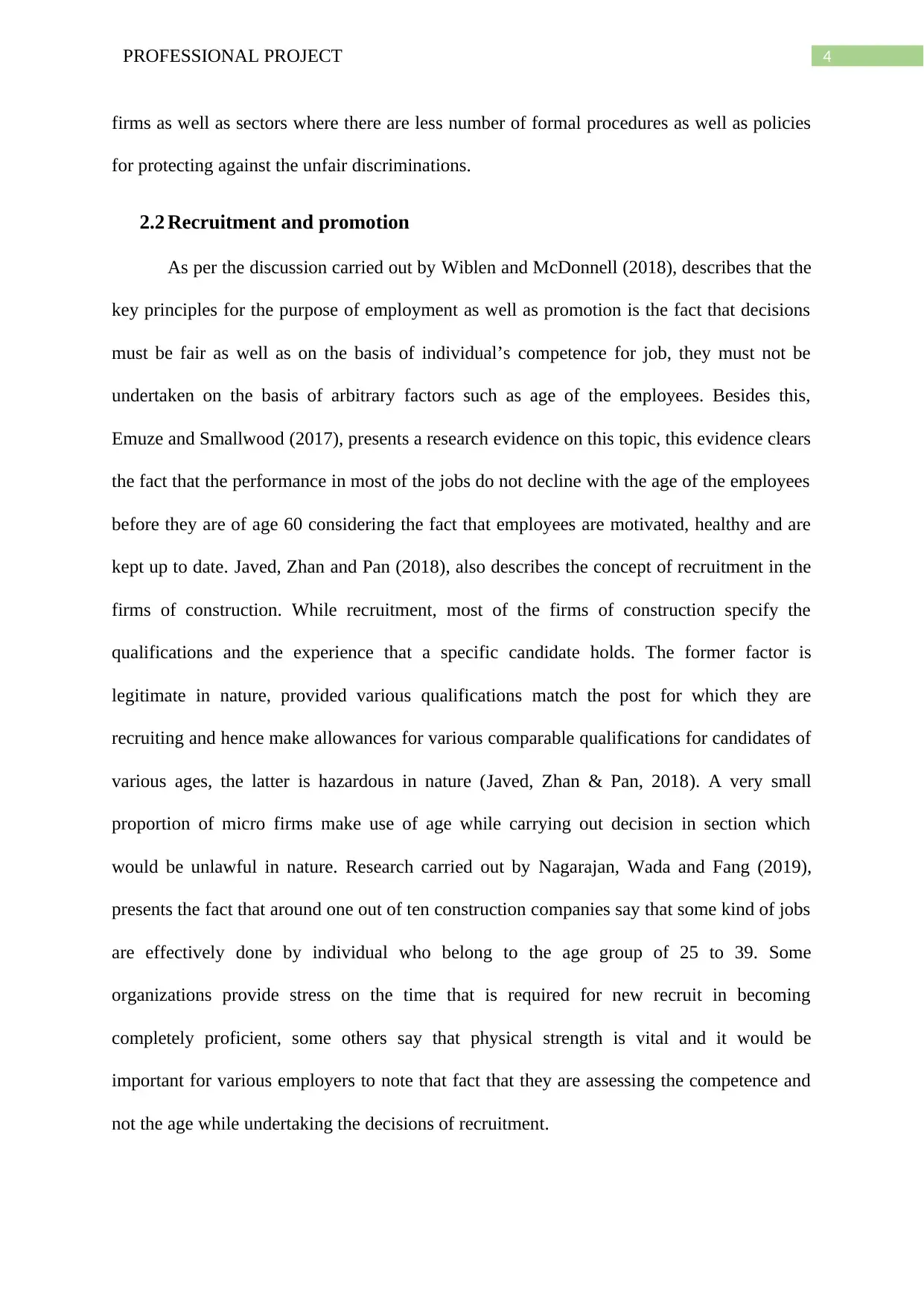
4PROFESSIONAL PROJECT
firms as well as sectors where there are less number of formal procedures as well as policies
for protecting against the unfair discriminations.
2.2 Recruitment and promotion
As per the discussion carried out by Wiblen and McDonnell (2018), describes that the
key principles for the purpose of employment as well as promotion is the fact that decisions
must be fair as well as on the basis of individual’s competence for job, they must not be
undertaken on the basis of arbitrary factors such as age of the employees. Besides this,
Emuze and Smallwood (2017), presents a research evidence on this topic, this evidence clears
the fact that the performance in most of the jobs do not decline with the age of the employees
before they are of age 60 considering the fact that employees are motivated, healthy and are
kept up to date. Javed, Zhan and Pan (2018), also describes the concept of recruitment in the
firms of construction. While recruitment, most of the firms of construction specify the
qualifications and the experience that a specific candidate holds. The former factor is
legitimate in nature, provided various qualifications match the post for which they are
recruiting and hence make allowances for various comparable qualifications for candidates of
various ages, the latter is hazardous in nature (Javed, Zhan & Pan, 2018). A very small
proportion of micro firms make use of age while carrying out decision in section which
would be unlawful in nature. Research carried out by Nagarajan, Wada and Fang (2019),
presents the fact that around one out of ten construction companies say that some kind of jobs
are effectively done by individual who belong to the age group of 25 to 39. Some
organizations provide stress on the time that is required for new recruit in becoming
completely proficient, some others say that physical strength is vital and it would be
important for various employers to note that fact that they are assessing the competence and
not the age while undertaking the decisions of recruitment.
firms as well as sectors where there are less number of formal procedures as well as policies
for protecting against the unfair discriminations.
2.2 Recruitment and promotion
As per the discussion carried out by Wiblen and McDonnell (2018), describes that the
key principles for the purpose of employment as well as promotion is the fact that decisions
must be fair as well as on the basis of individual’s competence for job, they must not be
undertaken on the basis of arbitrary factors such as age of the employees. Besides this,
Emuze and Smallwood (2017), presents a research evidence on this topic, this evidence clears
the fact that the performance in most of the jobs do not decline with the age of the employees
before they are of age 60 considering the fact that employees are motivated, healthy and are
kept up to date. Javed, Zhan and Pan (2018), also describes the concept of recruitment in the
firms of construction. While recruitment, most of the firms of construction specify the
qualifications and the experience that a specific candidate holds. The former factor is
legitimate in nature, provided various qualifications match the post for which they are
recruiting and hence make allowances for various comparable qualifications for candidates of
various ages, the latter is hazardous in nature (Javed, Zhan & Pan, 2018). A very small
proportion of micro firms make use of age while carrying out decision in section which
would be unlawful in nature. Research carried out by Nagarajan, Wada and Fang (2019),
presents the fact that around one out of ten construction companies say that some kind of jobs
are effectively done by individual who belong to the age group of 25 to 39. Some
organizations provide stress on the time that is required for new recruit in becoming
completely proficient, some others say that physical strength is vital and it would be
important for various employers to note that fact that they are assessing the competence and
not the age while undertaking the decisions of recruitment.
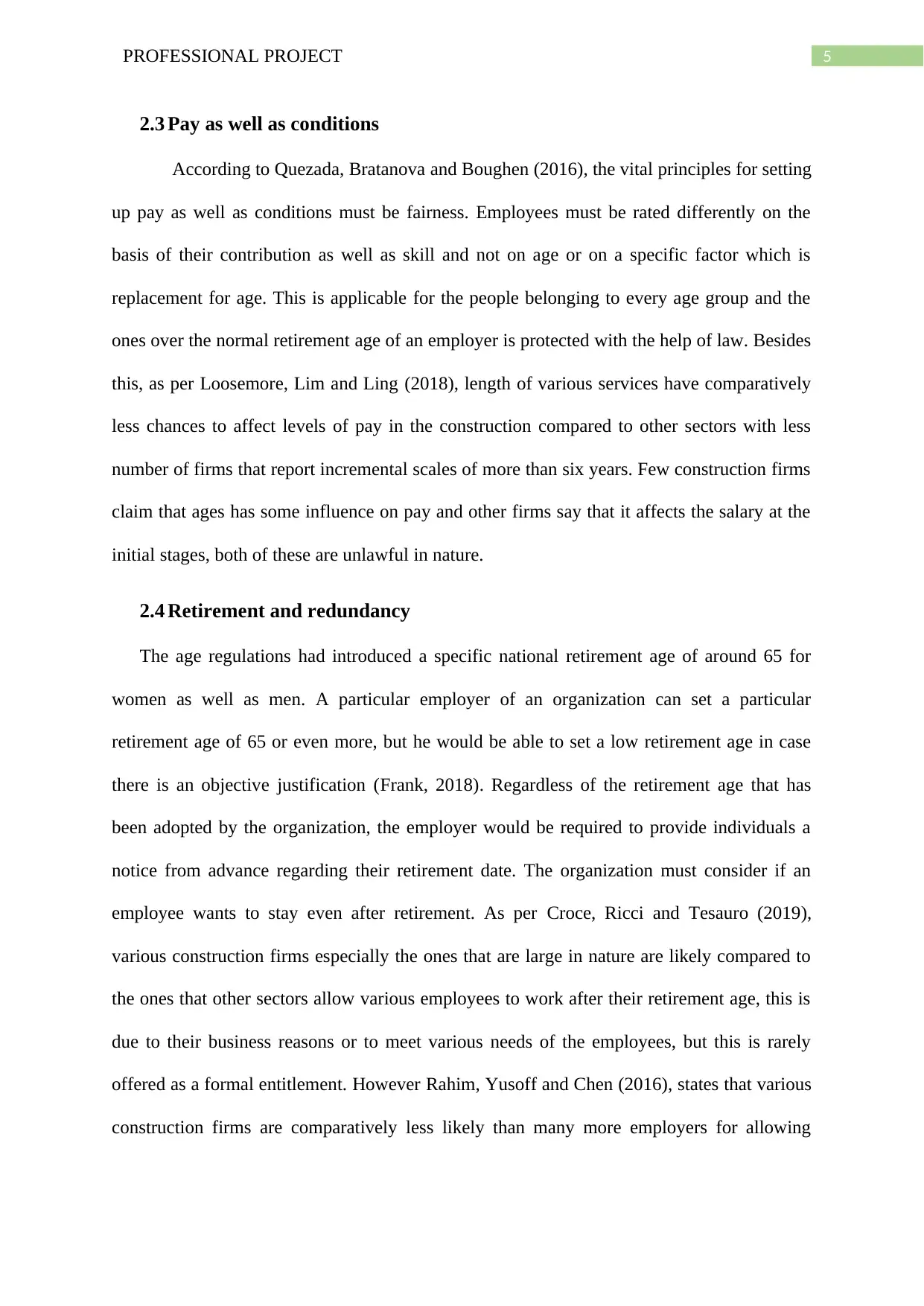
5PROFESSIONAL PROJECT
2.3 Pay as well as conditions
According to Quezada, Bratanova and Boughen (2016), the vital principles for setting
up pay as well as conditions must be fairness. Employees must be rated differently on the
basis of their contribution as well as skill and not on age or on a specific factor which is
replacement for age. This is applicable for the people belonging to every age group and the
ones over the normal retirement age of an employer is protected with the help of law. Besides
this, as per Loosemore, Lim and Ling (2018), length of various services have comparatively
less chances to affect levels of pay in the construction compared to other sectors with less
number of firms that report incremental scales of more than six years. Few construction firms
claim that ages has some influence on pay and other firms say that it affects the salary at the
initial stages, both of these are unlawful in nature.
2.4 Retirement and redundancy
The age regulations had introduced a specific national retirement age of around 65 for
women as well as men. A particular employer of an organization can set a particular
retirement age of 65 or even more, but he would be able to set a low retirement age in case
there is an objective justification (Frank, 2018). Regardless of the retirement age that has
been adopted by the organization, the employer would be required to provide individuals a
notice from advance regarding their retirement date. The organization must consider if an
employee wants to stay even after retirement. As per Croce, Ricci and Tesauro (2019),
various construction firms especially the ones that are large in nature are likely compared to
the ones that other sectors allow various employees to work after their retirement age, this is
due to their business reasons or to meet various needs of the employees, but this is rarely
offered as a formal entitlement. However Rahim, Yusoff and Chen (2016), states that various
construction firms are comparatively less likely than many more employers for allowing
2.3 Pay as well as conditions
According to Quezada, Bratanova and Boughen (2016), the vital principles for setting
up pay as well as conditions must be fairness. Employees must be rated differently on the
basis of their contribution as well as skill and not on age or on a specific factor which is
replacement for age. This is applicable for the people belonging to every age group and the
ones over the normal retirement age of an employer is protected with the help of law. Besides
this, as per Loosemore, Lim and Ling (2018), length of various services have comparatively
less chances to affect levels of pay in the construction compared to other sectors with less
number of firms that report incremental scales of more than six years. Few construction firms
claim that ages has some influence on pay and other firms say that it affects the salary at the
initial stages, both of these are unlawful in nature.
2.4 Retirement and redundancy
The age regulations had introduced a specific national retirement age of around 65 for
women as well as men. A particular employer of an organization can set a particular
retirement age of 65 or even more, but he would be able to set a low retirement age in case
there is an objective justification (Frank, 2018). Regardless of the retirement age that has
been adopted by the organization, the employer would be required to provide individuals a
notice from advance regarding their retirement date. The organization must consider if an
employee wants to stay even after retirement. As per Croce, Ricci and Tesauro (2019),
various construction firms especially the ones that are large in nature are likely compared to
the ones that other sectors allow various employees to work after their retirement age, this is
due to their business reasons or to meet various needs of the employees, but this is rarely
offered as a formal entitlement. However Rahim, Yusoff and Chen (2016), states that various
construction firms are comparatively less likely than many more employers for allowing
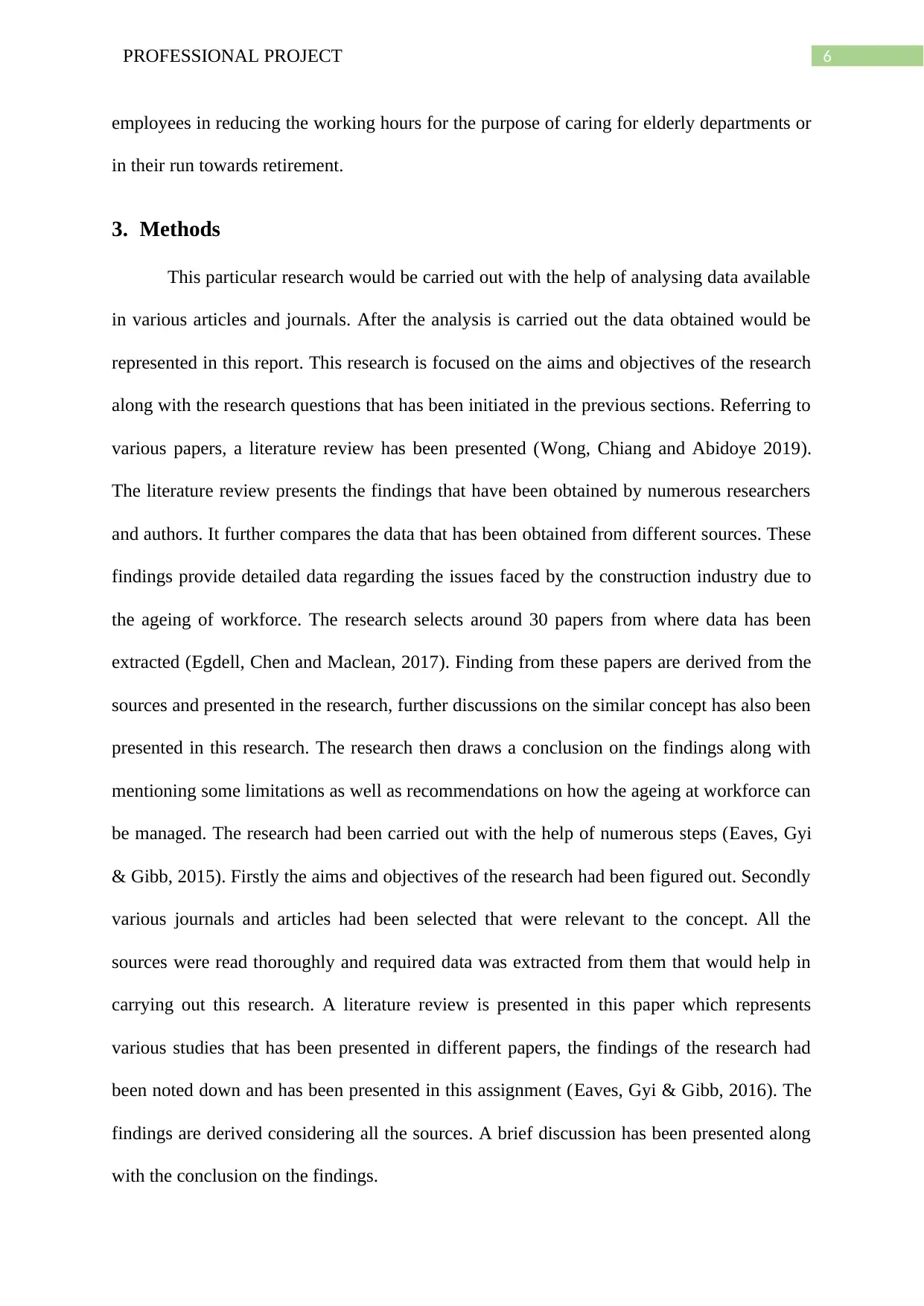
6PROFESSIONAL PROJECT
employees in reducing the working hours for the purpose of caring for elderly departments or
in their run towards retirement.
3. Methods
This particular research would be carried out with the help of analysing data available
in various articles and journals. After the analysis is carried out the data obtained would be
represented in this report. This research is focused on the aims and objectives of the research
along with the research questions that has been initiated in the previous sections. Referring to
various papers, a literature review has been presented (Wong, Chiang and Abidoye 2019).
The literature review presents the findings that have been obtained by numerous researchers
and authors. It further compares the data that has been obtained from different sources. These
findings provide detailed data regarding the issues faced by the construction industry due to
the ageing of workforce. The research selects around 30 papers from where data has been
extracted (Egdell, Chen and Maclean, 2017). Finding from these papers are derived from the
sources and presented in the research, further discussions on the similar concept has also been
presented in this research. The research then draws a conclusion on the findings along with
mentioning some limitations as well as recommendations on how the ageing at workforce can
be managed. The research had been carried out with the help of numerous steps (Eaves, Gyi
& Gibb, 2015). Firstly the aims and objectives of the research had been figured out. Secondly
various journals and articles had been selected that were relevant to the concept. All the
sources were read thoroughly and required data was extracted from them that would help in
carrying out this research. A literature review is presented in this paper which represents
various studies that has been presented in different papers, the findings of the research had
been noted down and has been presented in this assignment (Eaves, Gyi & Gibb, 2016). The
findings are derived considering all the sources. A brief discussion has been presented along
with the conclusion on the findings.
employees in reducing the working hours for the purpose of caring for elderly departments or
in their run towards retirement.
3. Methods
This particular research would be carried out with the help of analysing data available
in various articles and journals. After the analysis is carried out the data obtained would be
represented in this report. This research is focused on the aims and objectives of the research
along with the research questions that has been initiated in the previous sections. Referring to
various papers, a literature review has been presented (Wong, Chiang and Abidoye 2019).
The literature review presents the findings that have been obtained by numerous researchers
and authors. It further compares the data that has been obtained from different sources. These
findings provide detailed data regarding the issues faced by the construction industry due to
the ageing of workforce. The research selects around 30 papers from where data has been
extracted (Egdell, Chen and Maclean, 2017). Finding from these papers are derived from the
sources and presented in the research, further discussions on the similar concept has also been
presented in this research. The research then draws a conclusion on the findings along with
mentioning some limitations as well as recommendations on how the ageing at workforce can
be managed. The research had been carried out with the help of numerous steps (Eaves, Gyi
& Gibb, 2015). Firstly the aims and objectives of the research had been figured out. Secondly
various journals and articles had been selected that were relevant to the concept. All the
sources were read thoroughly and required data was extracted from them that would help in
carrying out this research. A literature review is presented in this paper which represents
various studies that has been presented in different papers, the findings of the research had
been noted down and has been presented in this assignment (Eaves, Gyi & Gibb, 2016). The
findings are derived considering all the sources. A brief discussion has been presented along
with the conclusion on the findings.
Paraphrase This Document
Need a fresh take? Get an instant paraphrase of this document with our AI Paraphraser

7PROFESSIONAL PROJECT
4. Findings from secondary data analysis
4.1 Data analysis
In the process of data analysis, graphical representation has been carried out for the
purpose of understanding the fact that older workers in the construction industry are more
vulnerable to accidents from occupational injury as compared to young workers, table
provided below represents data regarding it
Reason of injury and injury
type
Affected body parts Related cost of the injuries
Falls, trips and slips (26,
20)
Fractures (20)
MSD (19-24, 26, 23, 29)
Mesothelioma (19)
Pneumoconiosis (30)
Asbestosis (18)
Hearing loss (20)
Abrasion/ contusion (19)
Neck (25)
Black (26,29)
Lower extremities (17, 29)
Upper extremities (28)
Increase in days of
hospitalization (6, 19)
Retirement (10)
Disability (25)
Loss of work days (15)
Increase in monetary cost
(5, 20)
Limitation of functions
(6,20)
Death (15, 34)
Table 1: age and injury of workers in construction workers.
(Source: created by author)
According to various researchers who had carried out primary data analysis and
represented data regarding this, they had carried out a survey on around 100 respondents
and among them only 39 had responded or answered to the questions, this has contributed
only about 39 percent of the findings. The greatest percentage who had responded age
4. Findings from secondary data analysis
4.1 Data analysis
In the process of data analysis, graphical representation has been carried out for the
purpose of understanding the fact that older workers in the construction industry are more
vulnerable to accidents from occupational injury as compared to young workers, table
provided below represents data regarding it
Reason of injury and injury
type
Affected body parts Related cost of the injuries
Falls, trips and slips (26,
20)
Fractures (20)
MSD (19-24, 26, 23, 29)
Mesothelioma (19)
Pneumoconiosis (30)
Asbestosis (18)
Hearing loss (20)
Abrasion/ contusion (19)
Neck (25)
Black (26,29)
Lower extremities (17, 29)
Upper extremities (28)
Increase in days of
hospitalization (6, 19)
Retirement (10)
Disability (25)
Loss of work days (15)
Increase in monetary cost
(5, 20)
Limitation of functions
(6,20)
Death (15, 34)
Table 1: age and injury of workers in construction workers.
(Source: created by author)
According to various researchers who had carried out primary data analysis and
represented data regarding this, they had carried out a survey on around 100 respondents
and among them only 39 had responded or answered to the questions, this has contributed
only about 39 percent of the findings. The greatest percentage who had responded age

8PROFESSIONAL PROJECT
ranged from 21 to 30 years old. The age of respondents from 41 to 20 years had been the
minimum. Among this the female respondents were around 56.41 percent and male were
around 43.59 percent.
1
2
3
4
5
0.00% 10.00% 20.00% 30.00% 40.00% 50.00% 60.00% 70.00% 80.00%
Chart Title
Figure 1: respondents’ age range
(Source: created by author)
0 10 20 30 40 50 60
0.00%
10.00%
20.00%
30.00%
40.00%
50.00%
60.00%
70.00%
7.69%
23.08%
10.26%
2.56% 2.56%
58.85%
Chart Title
Series 1 Column2
Figure 2: employee capacity of respondents
ranged from 21 to 30 years old. The age of respondents from 41 to 20 years had been the
minimum. Among this the female respondents were around 56.41 percent and male were
around 43.59 percent.
1
2
3
4
5
0.00% 10.00% 20.00% 30.00% 40.00% 50.00% 60.00% 70.00% 80.00%
Chart Title
Figure 1: respondents’ age range
(Source: created by author)
0 10 20 30 40 50 60
0.00%
10.00%
20.00%
30.00%
40.00%
50.00%
60.00%
70.00%
7.69%
23.08%
10.26%
2.56% 2.56%
58.85%
Chart Title
Series 1 Column2
Figure 2: employee capacity of respondents
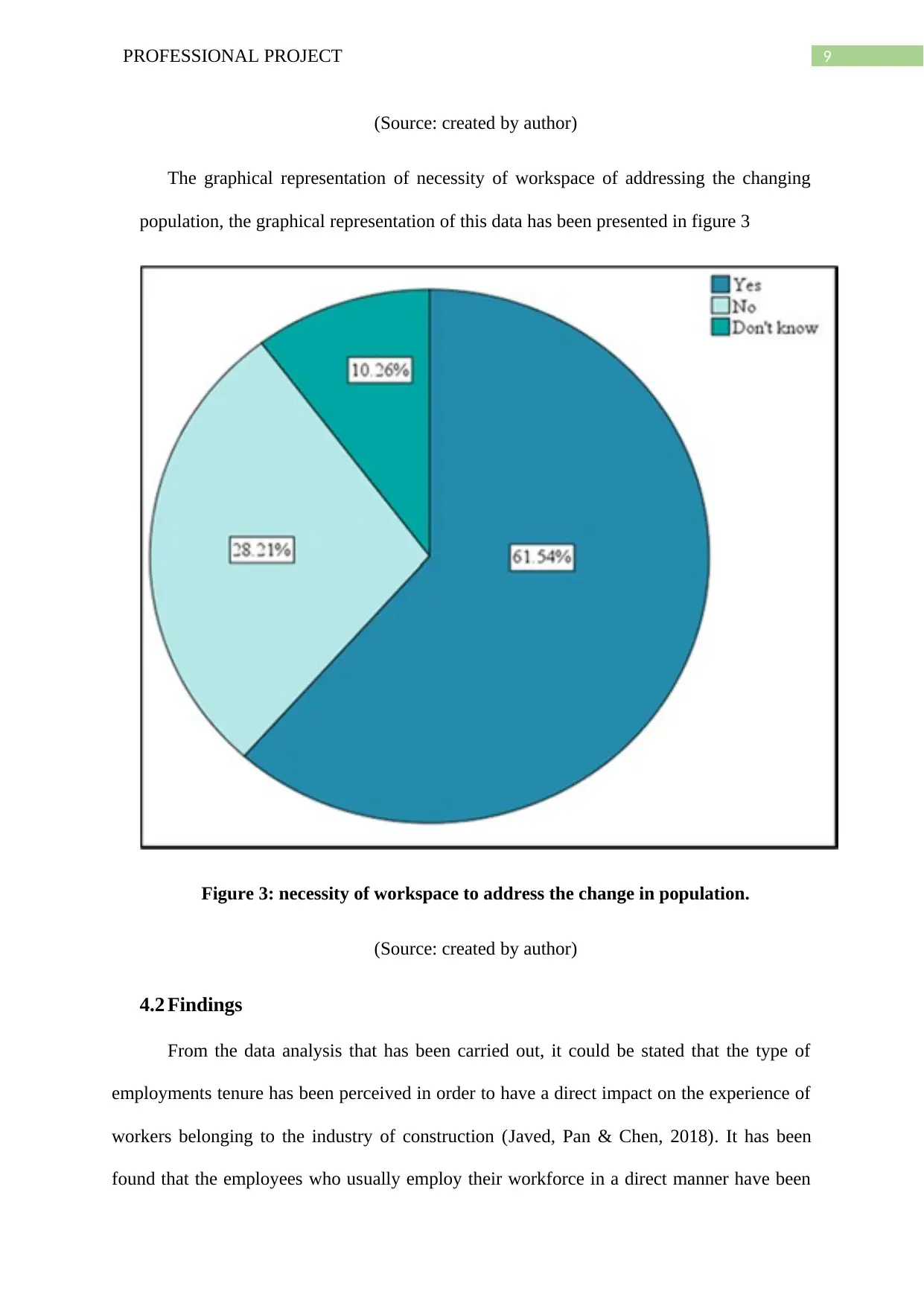
9PROFESSIONAL PROJECT
(Source: created by author)
The graphical representation of necessity of workspace of addressing the changing
population, the graphical representation of this data has been presented in figure 3
Figure 3: necessity of workspace to address the change in population.
(Source: created by author)
4.2 Findings
From the data analysis that has been carried out, it could be stated that the type of
employments tenure has been perceived in order to have a direct impact on the experience of
workers belonging to the industry of construction (Javed, Pan & Chen, 2018). It has been
found that the employees who usually employ their workforce in a direct manner have been
(Source: created by author)
The graphical representation of necessity of workspace of addressing the changing
population, the graphical representation of this data has been presented in figure 3
Figure 3: necessity of workspace to address the change in population.
(Source: created by author)
4.2 Findings
From the data analysis that has been carried out, it could be stated that the type of
employments tenure has been perceived in order to have a direct impact on the experience of
workers belonging to the industry of construction (Javed, Pan & Chen, 2018). It has been
found that the employees who usually employ their workforce in a direct manner have been
Secure Best Marks with AI Grader
Need help grading? Try our AI Grader for instant feedback on your assignments.

10PROFESSIONAL PROJECT
perceived as necessity to look after their elder workers because they find them less
demanding in the terms of physical strength when required. They are also forced to provide
the workers with a sick pay when a particular worker is not able to work throughout his ill
health or any sort of injury (Alessandrini & Winter, 2015). In the case of being self-
employees and looking for work with the help of subcontractors, workers are usually
perceived to be selected for a job on the factors like fitness and ability to complete a specific
job in the given time along with maintaining the quality in their work. Allowances are not
introduced for the older workers’ slower pace. In case a self-employed worker is not able to
work due to bad health, he or she would not be paid and hence should rely on state benefits or
private insurance. Most of the older workers in the UK had reported that they would like to
be employed directly (Pak, Kooij & De Lange, 2018). It has also been found from the above
discussion that the industry of construction is very competitive. The financial pressure
usually results in a very tight margins. There has been a particular percent regarding the fact
that small margins make it impossible for the industry to make allowances for workers who
are old or physically slow (Gahan, Harbridge & Healy, 2017). This is due to the competitive
rendering process, numerous contractors are reluctant in bearing this cost. It has been
suggested by numerous participants that one way in which this issue can be resolved include
bearing the cost by the client (Ksiazek & Nowak, 2017). In various times of severe downturn
of economy as well as industrial restructuring workers more than 45 years are notices to be
less productive and hence they must exit the workforce for the purpose of opening
opportunities for the young generation (Jia, Rowlinson & Loosemore, 2017). This trend has
occurred in numerous developed countries all over the world.
5. Discussions of findings
The data that has been presented above reflect on the pay structure that exists in the
construction industry. This is because the elder employees are considered to be less
perceived as necessity to look after their elder workers because they find them less
demanding in the terms of physical strength when required. They are also forced to provide
the workers with a sick pay when a particular worker is not able to work throughout his ill
health or any sort of injury (Alessandrini & Winter, 2015). In the case of being self-
employees and looking for work with the help of subcontractors, workers are usually
perceived to be selected for a job on the factors like fitness and ability to complete a specific
job in the given time along with maintaining the quality in their work. Allowances are not
introduced for the older workers’ slower pace. In case a self-employed worker is not able to
work due to bad health, he or she would not be paid and hence should rely on state benefits or
private insurance. Most of the older workers in the UK had reported that they would like to
be employed directly (Pak, Kooij & De Lange, 2018). It has also been found from the above
discussion that the industry of construction is very competitive. The financial pressure
usually results in a very tight margins. There has been a particular percent regarding the fact
that small margins make it impossible for the industry to make allowances for workers who
are old or physically slow (Gahan, Harbridge & Healy, 2017). This is due to the competitive
rendering process, numerous contractors are reluctant in bearing this cost. It has been
suggested by numerous participants that one way in which this issue can be resolved include
bearing the cost by the client (Ksiazek & Nowak, 2017). In various times of severe downturn
of economy as well as industrial restructuring workers more than 45 years are notices to be
less productive and hence they must exit the workforce for the purpose of opening
opportunities for the young generation (Jia, Rowlinson & Loosemore, 2017). This trend has
occurred in numerous developed countries all over the world.
5. Discussions of findings
The data that has been presented above reflect on the pay structure that exists in the
construction industry. This is because the elder employees are considered to be less
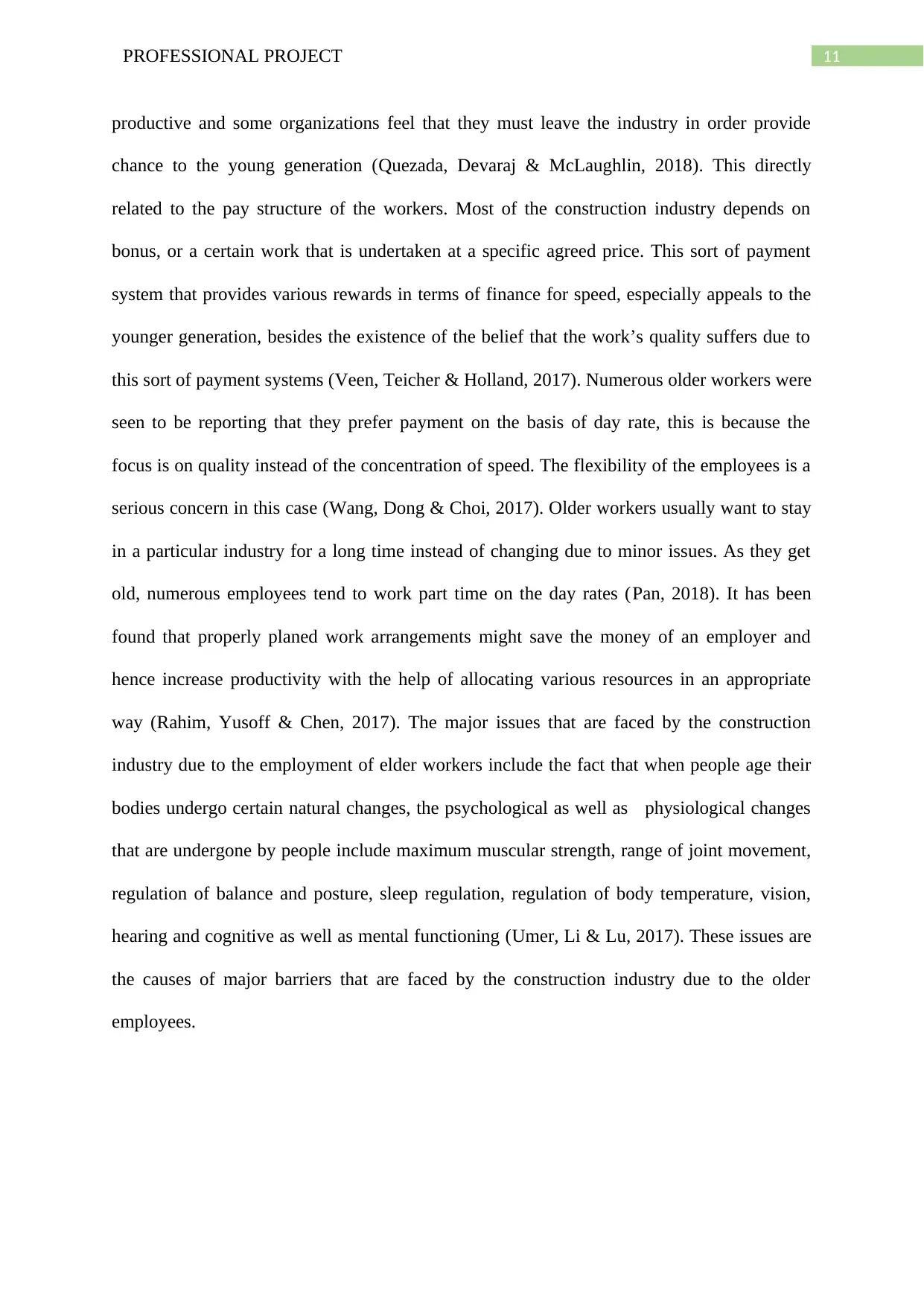
11PROFESSIONAL PROJECT
productive and some organizations feel that they must leave the industry in order provide
chance to the young generation (Quezada, Devaraj & McLaughlin, 2018). This directly
related to the pay structure of the workers. Most of the construction industry depends on
bonus, or a certain work that is undertaken at a specific agreed price. This sort of payment
system that provides various rewards in terms of finance for speed, especially appeals to the
younger generation, besides the existence of the belief that the work’s quality suffers due to
this sort of payment systems (Veen, Teicher & Holland, 2017). Numerous older workers were
seen to be reporting that they prefer payment on the basis of day rate, this is because the
focus is on quality instead of the concentration of speed. The flexibility of the employees is a
serious concern in this case (Wang, Dong & Choi, 2017). Older workers usually want to stay
in a particular industry for a long time instead of changing due to minor issues. As they get
old, numerous employees tend to work part time on the day rates (Pan, 2018). It has been
found that properly planed work arrangements might save the money of an employer and
hence increase productivity with the help of allocating various resources in an appropriate
way (Rahim, Yusoff & Chen, 2017). The major issues that are faced by the construction
industry due to the employment of elder workers include the fact that when people age their
bodies undergo certain natural changes, the psychological as well as physiological changes
that are undergone by people include maximum muscular strength, range of joint movement,
regulation of balance and posture, sleep regulation, regulation of body temperature, vision,
hearing and cognitive as well as mental functioning (Umer, Li & Lu, 2017). These issues are
the causes of major barriers that are faced by the construction industry due to the older
employees.
productive and some organizations feel that they must leave the industry in order provide
chance to the young generation (Quezada, Devaraj & McLaughlin, 2018). This directly
related to the pay structure of the workers. Most of the construction industry depends on
bonus, or a certain work that is undertaken at a specific agreed price. This sort of payment
system that provides various rewards in terms of finance for speed, especially appeals to the
younger generation, besides the existence of the belief that the work’s quality suffers due to
this sort of payment systems (Veen, Teicher & Holland, 2017). Numerous older workers were
seen to be reporting that they prefer payment on the basis of day rate, this is because the
focus is on quality instead of the concentration of speed. The flexibility of the employees is a
serious concern in this case (Wang, Dong & Choi, 2017). Older workers usually want to stay
in a particular industry for a long time instead of changing due to minor issues. As they get
old, numerous employees tend to work part time on the day rates (Pan, 2018). It has been
found that properly planed work arrangements might save the money of an employer and
hence increase productivity with the help of allocating various resources in an appropriate
way (Rahim, Yusoff & Chen, 2017). The major issues that are faced by the construction
industry due to the employment of elder workers include the fact that when people age their
bodies undergo certain natural changes, the psychological as well as physiological changes
that are undergone by people include maximum muscular strength, range of joint movement,
regulation of balance and posture, sleep regulation, regulation of body temperature, vision,
hearing and cognitive as well as mental functioning (Umer, Li & Lu, 2017). These issues are
the causes of major barriers that are faced by the construction industry due to the older
employees.

12PROFESSIONAL PROJECT
6. Conclusion
From the above assignment, it could be stated that along with the construction
workforce ageing and numerous baby boomers are moving towards the age of retirement. The
industry would require to prepare for impending various skilled workers shortage and the
necessity to keep the employees in the workforce for a longer period of time. It has been
estimated by various researchers that by the year of 2030, people of around 55 years old and
even elder to them would make up around 40 percent of the adult population. Provided the
demographic data of the ageing workforce in the construction industry, employees are to be
educated regarding the strategies that could be used for the purpose of reducing the potential
impact. In case workers keep on delaying the retirement, the concerns of health as well as
safety requirements of an elderly workforce would become more important in the upcoming
future. It has been found that recruiting as well as training new workers would help the
industry in eliminating the issue of less amount of workforce in the industry. Besides these
there have been numerous ways by which the issue of workforce ageing in the construction
industry could be solved. The data is represented referring from various sources. Age
discrimination is considered as a major issue in the industry of construction. There are
numerous laws that have been enforced for the purpose of reducing the discrimination of age
due to the inability of elder employees to work effectively in various construction sites.
Various discriminatory attitudes has been a common issue faced by the construction industry.
This particular assignment presents some more issues that are faced by the construction
industry due to ageing workforce. Various sources like journals and articles had been
considered for presenting the data that has been derived. Recommendations for the purpose of
managing the ageing workforce in construction industry would help the filed in considering
simple changes in the working environment, these recpmmendatiosn have been presented in
the recommendations part. The data obtained from various sources are presented critically in
6. Conclusion
From the above assignment, it could be stated that along with the construction
workforce ageing and numerous baby boomers are moving towards the age of retirement. The
industry would require to prepare for impending various skilled workers shortage and the
necessity to keep the employees in the workforce for a longer period of time. It has been
estimated by various researchers that by the year of 2030, people of around 55 years old and
even elder to them would make up around 40 percent of the adult population. Provided the
demographic data of the ageing workforce in the construction industry, employees are to be
educated regarding the strategies that could be used for the purpose of reducing the potential
impact. In case workers keep on delaying the retirement, the concerns of health as well as
safety requirements of an elderly workforce would become more important in the upcoming
future. It has been found that recruiting as well as training new workers would help the
industry in eliminating the issue of less amount of workforce in the industry. Besides these
there have been numerous ways by which the issue of workforce ageing in the construction
industry could be solved. The data is represented referring from various sources. Age
discrimination is considered as a major issue in the industry of construction. There are
numerous laws that have been enforced for the purpose of reducing the discrimination of age
due to the inability of elder employees to work effectively in various construction sites.
Various discriminatory attitudes has been a common issue faced by the construction industry.
This particular assignment presents some more issues that are faced by the construction
industry due to ageing workforce. Various sources like journals and articles had been
considered for presenting the data that has been derived. Recommendations for the purpose of
managing the ageing workforce in construction industry would help the filed in considering
simple changes in the working environment, these recpmmendatiosn have been presented in
the recommendations part. The data obtained from various sources are presented critically in
Paraphrase This Document
Need a fresh take? Get an instant paraphrase of this document with our AI Paraphraser

13PROFESSIONAL PROJECT
this assignment. It further presents the methods that have been used for the purpose of
carrying out these research. The findings and results have been presented in this assignment.
6.1.Recommendations
Various recommendations for the purpose of managing the ageing workforce in
construction industry would help the filed in considering simple changes in the working
environment for keeping the ageing workers safe, productive along with healthy (Eaves, Gyi
& Gibb, 2015). Various factors that could be considered for dealing with is issue of ageing
workforce are as follows
Recruiting as well as training various new workers for the industry of construction
would help them in eliminating the shortfall, it would be required to enact the retirement as
well as pension policy changes that would be designed for the purpose of raising the effective
age of the retirement (Pak, Kooij & De Lange, 2018). The ageing workforce would need the
employees to be more educated on the concept of disability management along with the needs
of their old employees who might lose their ability of retaining this segment of the workers.
Employers could encourage the employees for participating in a home or a specific
gym based program of exercise. Implementation of onsite as well as supervised program for
fitness could help in promoting wellness of workers and hence pay dividends in a form of
reduced injuries and hence lower the compensation costs of workers. A particular
comprehensive program could make use of external health care providers for providing
lectures on wellness topics like nutrition, disease prevention and weight control. Some other
topics might focus on various conditions that are related to age like arthritis.
Innovation of hiring proper training as well as workplace evaluation along with a
comprehensive disability management program are various important tools which would help
in keeping employees of all the ages healthy safe as well as productive. Employers should
this assignment. It further presents the methods that have been used for the purpose of
carrying out these research. The findings and results have been presented in this assignment.
6.1.Recommendations
Various recommendations for the purpose of managing the ageing workforce in
construction industry would help the filed in considering simple changes in the working
environment for keeping the ageing workers safe, productive along with healthy (Eaves, Gyi
& Gibb, 2015). Various factors that could be considered for dealing with is issue of ageing
workforce are as follows
Recruiting as well as training various new workers for the industry of construction
would help them in eliminating the shortfall, it would be required to enact the retirement as
well as pension policy changes that would be designed for the purpose of raising the effective
age of the retirement (Pak, Kooij & De Lange, 2018). The ageing workforce would need the
employees to be more educated on the concept of disability management along with the needs
of their old employees who might lose their ability of retaining this segment of the workers.
Employers could encourage the employees for participating in a home or a specific
gym based program of exercise. Implementation of onsite as well as supervised program for
fitness could help in promoting wellness of workers and hence pay dividends in a form of
reduced injuries and hence lower the compensation costs of workers. A particular
comprehensive program could make use of external health care providers for providing
lectures on wellness topics like nutrition, disease prevention and weight control. Some other
topics might focus on various conditions that are related to age like arthritis.
Innovation of hiring proper training as well as workplace evaluation along with a
comprehensive disability management program are various important tools which would help
in keeping employees of all the ages healthy safe as well as productive. Employers should
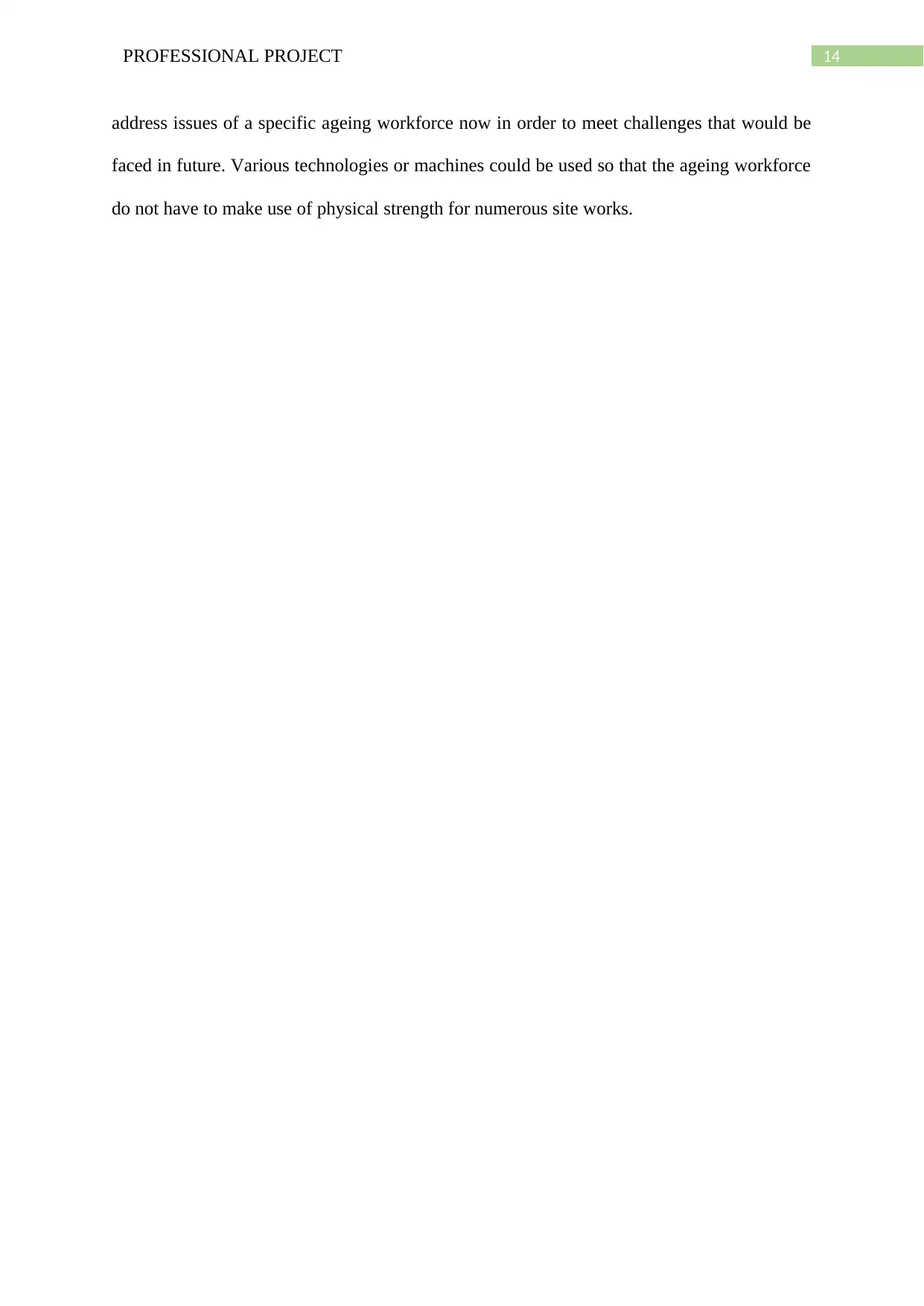
14PROFESSIONAL PROJECT
address issues of a specific ageing workforce now in order to meet challenges that would be
faced in future. Various technologies or machines could be used so that the ageing workforce
do not have to make use of physical strength for numerous site works.
address issues of a specific ageing workforce now in order to meet challenges that would be
faced in future. Various technologies or machines could be used so that the ageing workforce
do not have to make use of physical strength for numerous site works.
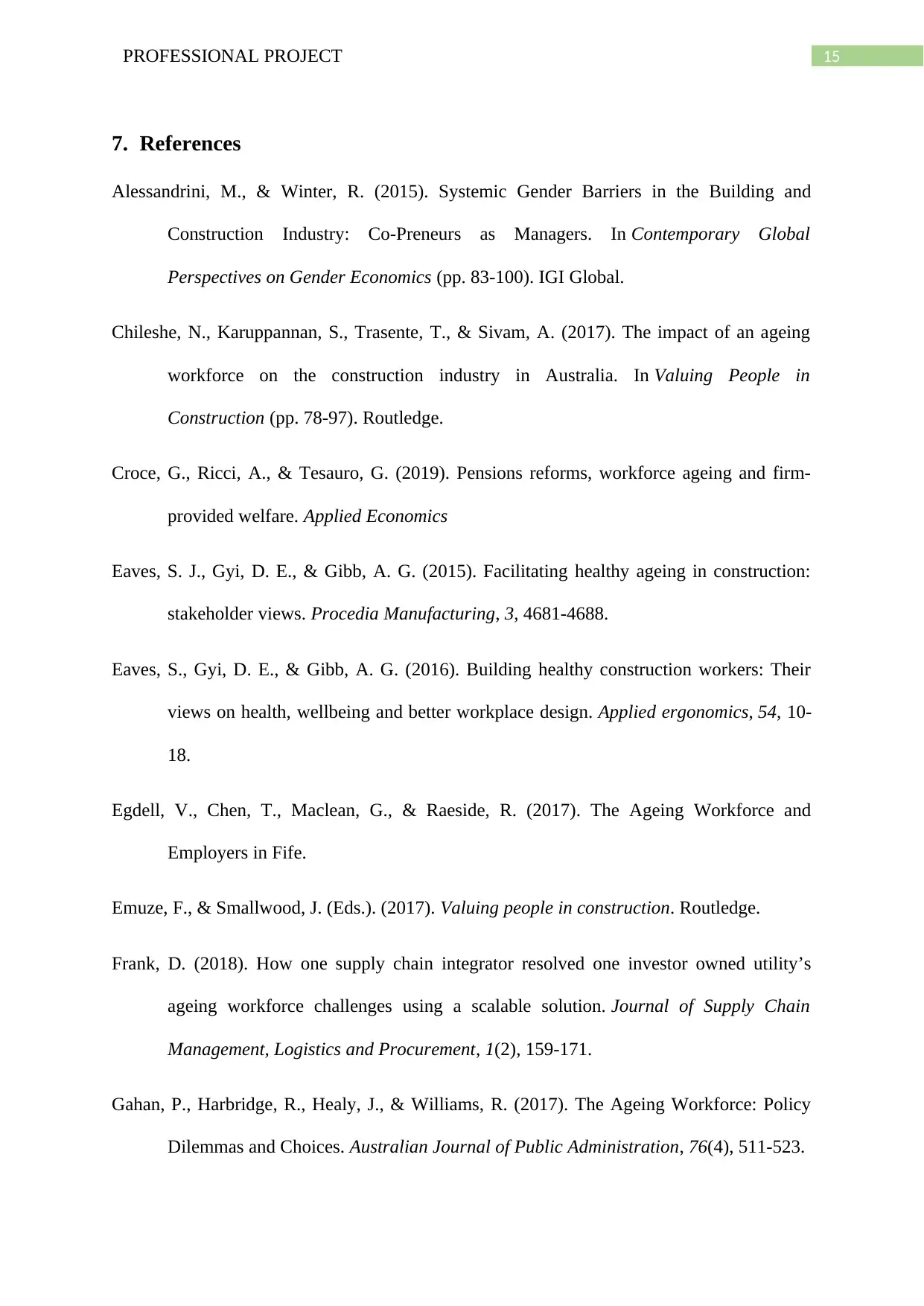
15PROFESSIONAL PROJECT
7. References
Alessandrini, M., & Winter, R. (2015). Systemic Gender Barriers in the Building and
Construction Industry: Co-Preneurs as Managers. In Contemporary Global
Perspectives on Gender Economics (pp. 83-100). IGI Global.
Chileshe, N., Karuppannan, S., Trasente, T., & Sivam, A. (2017). The impact of an ageing
workforce on the construction industry in Australia. In Valuing People in
Construction (pp. 78-97). Routledge.
Croce, G., Ricci, A., & Tesauro, G. (2019). Pensions reforms, workforce ageing and firm-
provided welfare. Applied Economics
Eaves, S. J., Gyi, D. E., & Gibb, A. G. (2015). Facilitating healthy ageing in construction:
stakeholder views. Procedia Manufacturing, 3, 4681-4688.
Eaves, S., Gyi, D. E., & Gibb, A. G. (2016). Building healthy construction workers: Their
views on health, wellbeing and better workplace design. Applied ergonomics, 54, 10-
18.
Egdell, V., Chen, T., Maclean, G., & Raeside, R. (2017). The Ageing Workforce and
Employers in Fife.
Emuze, F., & Smallwood, J. (Eds.). (2017). Valuing people in construction. Routledge.
Frank, D. (2018). How one supply chain integrator resolved one investor owned utility’s
ageing workforce challenges using a scalable solution. Journal of Supply Chain
Management, Logistics and Procurement, 1(2), 159-171.
Gahan, P., Harbridge, R., Healy, J., & Williams, R. (2017). The Ageing Workforce: Policy
Dilemmas and Choices. Australian Journal of Public Administration, 76(4), 511-523.
7. References
Alessandrini, M., & Winter, R. (2015). Systemic Gender Barriers in the Building and
Construction Industry: Co-Preneurs as Managers. In Contemporary Global
Perspectives on Gender Economics (pp. 83-100). IGI Global.
Chileshe, N., Karuppannan, S., Trasente, T., & Sivam, A. (2017). The impact of an ageing
workforce on the construction industry in Australia. In Valuing People in
Construction (pp. 78-97). Routledge.
Croce, G., Ricci, A., & Tesauro, G. (2019). Pensions reforms, workforce ageing and firm-
provided welfare. Applied Economics
Eaves, S. J., Gyi, D. E., & Gibb, A. G. (2015). Facilitating healthy ageing in construction:
stakeholder views. Procedia Manufacturing, 3, 4681-4688.
Eaves, S., Gyi, D. E., & Gibb, A. G. (2016). Building healthy construction workers: Their
views on health, wellbeing and better workplace design. Applied ergonomics, 54, 10-
18.
Egdell, V., Chen, T., Maclean, G., & Raeside, R. (2017). The Ageing Workforce and
Employers in Fife.
Emuze, F., & Smallwood, J. (Eds.). (2017). Valuing people in construction. Routledge.
Frank, D. (2018). How one supply chain integrator resolved one investor owned utility’s
ageing workforce challenges using a scalable solution. Journal of Supply Chain
Management, Logistics and Procurement, 1(2), 159-171.
Gahan, P., Harbridge, R., Healy, J., & Williams, R. (2017). The Ageing Workforce: Policy
Dilemmas and Choices. Australian Journal of Public Administration, 76(4), 511-523.
Secure Best Marks with AI Grader
Need help grading? Try our AI Grader for instant feedback on your assignments.
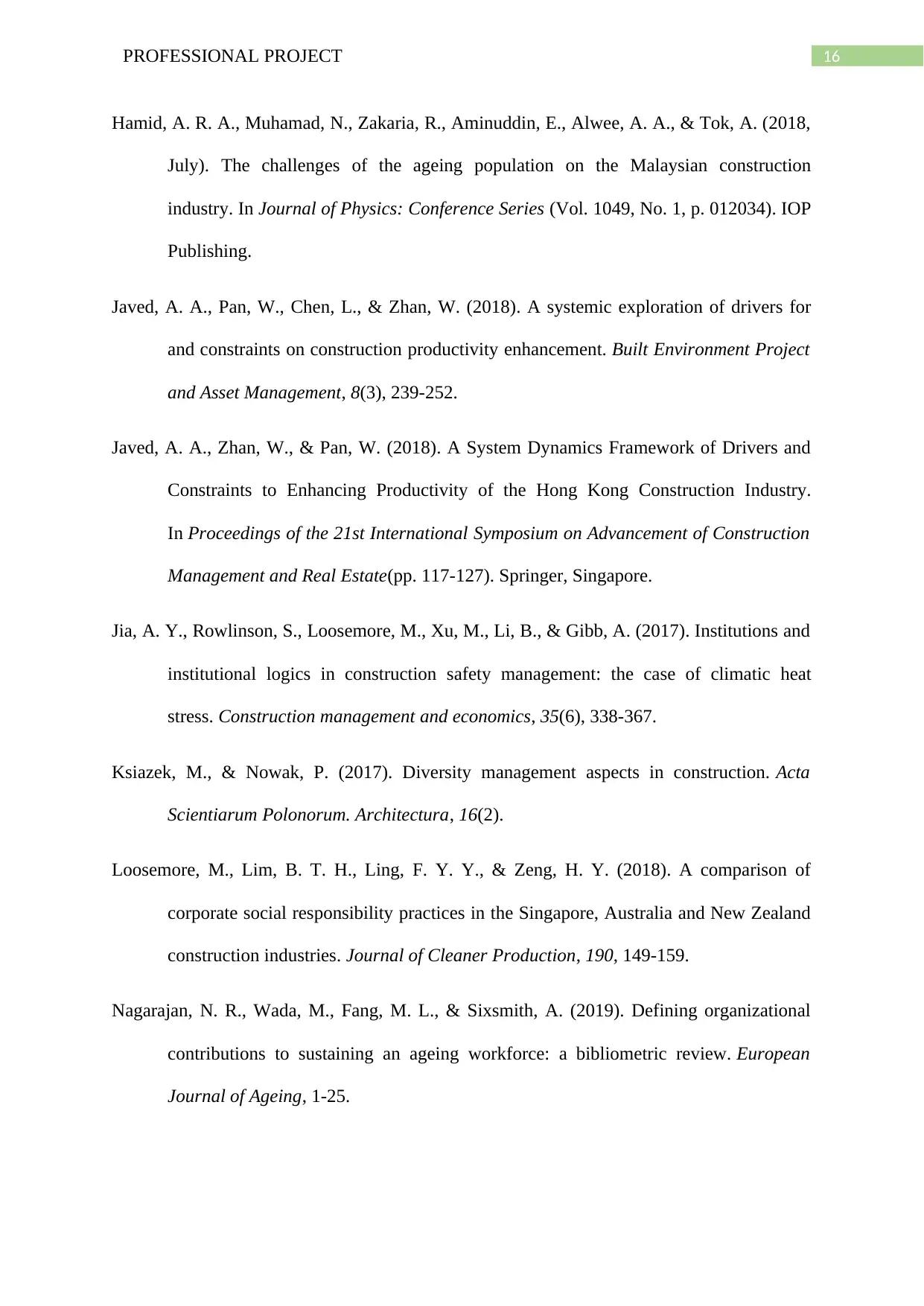
16PROFESSIONAL PROJECT
Hamid, A. R. A., Muhamad, N., Zakaria, R., Aminuddin, E., Alwee, A. A., & Tok, A. (2018,
July). The challenges of the ageing population on the Malaysian construction
industry. In Journal of Physics: Conference Series (Vol. 1049, No. 1, p. 012034). IOP
Publishing.
Javed, A. A., Pan, W., Chen, L., & Zhan, W. (2018). A systemic exploration of drivers for
and constraints on construction productivity enhancement. Built Environment Project
and Asset Management, 8(3), 239-252.
Javed, A. A., Zhan, W., & Pan, W. (2018). A System Dynamics Framework of Drivers and
Constraints to Enhancing Productivity of the Hong Kong Construction Industry.
In Proceedings of the 21st International Symposium on Advancement of Construction
Management and Real Estate(pp. 117-127). Springer, Singapore.
Jia, A. Y., Rowlinson, S., Loosemore, M., Xu, M., Li, B., & Gibb, A. (2017). Institutions and
institutional logics in construction safety management: the case of climatic heat
stress. Construction management and economics, 35(6), 338-367.
Ksiazek, M., & Nowak, P. (2017). Diversity management aspects in construction. Acta
Scientiarum Polonorum. Architectura, 16(2).
Loosemore, M., Lim, B. T. H., Ling, F. Y. Y., & Zeng, H. Y. (2018). A comparison of
corporate social responsibility practices in the Singapore, Australia and New Zealand
construction industries. Journal of Cleaner Production, 190, 149-159.
Nagarajan, N. R., Wada, M., Fang, M. L., & Sixsmith, A. (2019). Defining organizational
contributions to sustaining an ageing workforce: a bibliometric review. European
Journal of Ageing, 1-25.
Hamid, A. R. A., Muhamad, N., Zakaria, R., Aminuddin, E., Alwee, A. A., & Tok, A. (2018,
July). The challenges of the ageing population on the Malaysian construction
industry. In Journal of Physics: Conference Series (Vol. 1049, No. 1, p. 012034). IOP
Publishing.
Javed, A. A., Pan, W., Chen, L., & Zhan, W. (2018). A systemic exploration of drivers for
and constraints on construction productivity enhancement. Built Environment Project
and Asset Management, 8(3), 239-252.
Javed, A. A., Zhan, W., & Pan, W. (2018). A System Dynamics Framework of Drivers and
Constraints to Enhancing Productivity of the Hong Kong Construction Industry.
In Proceedings of the 21st International Symposium on Advancement of Construction
Management and Real Estate(pp. 117-127). Springer, Singapore.
Jia, A. Y., Rowlinson, S., Loosemore, M., Xu, M., Li, B., & Gibb, A. (2017). Institutions and
institutional logics in construction safety management: the case of climatic heat
stress. Construction management and economics, 35(6), 338-367.
Ksiazek, M., & Nowak, P. (2017). Diversity management aspects in construction. Acta
Scientiarum Polonorum. Architectura, 16(2).
Loosemore, M., Lim, B. T. H., Ling, F. Y. Y., & Zeng, H. Y. (2018). A comparison of
corporate social responsibility practices in the Singapore, Australia and New Zealand
construction industries. Journal of Cleaner Production, 190, 149-159.
Nagarajan, N. R., Wada, M., Fang, M. L., & Sixsmith, A. (2019). Defining organizational
contributions to sustaining an ageing workforce: a bibliometric review. European
Journal of Ageing, 1-25.
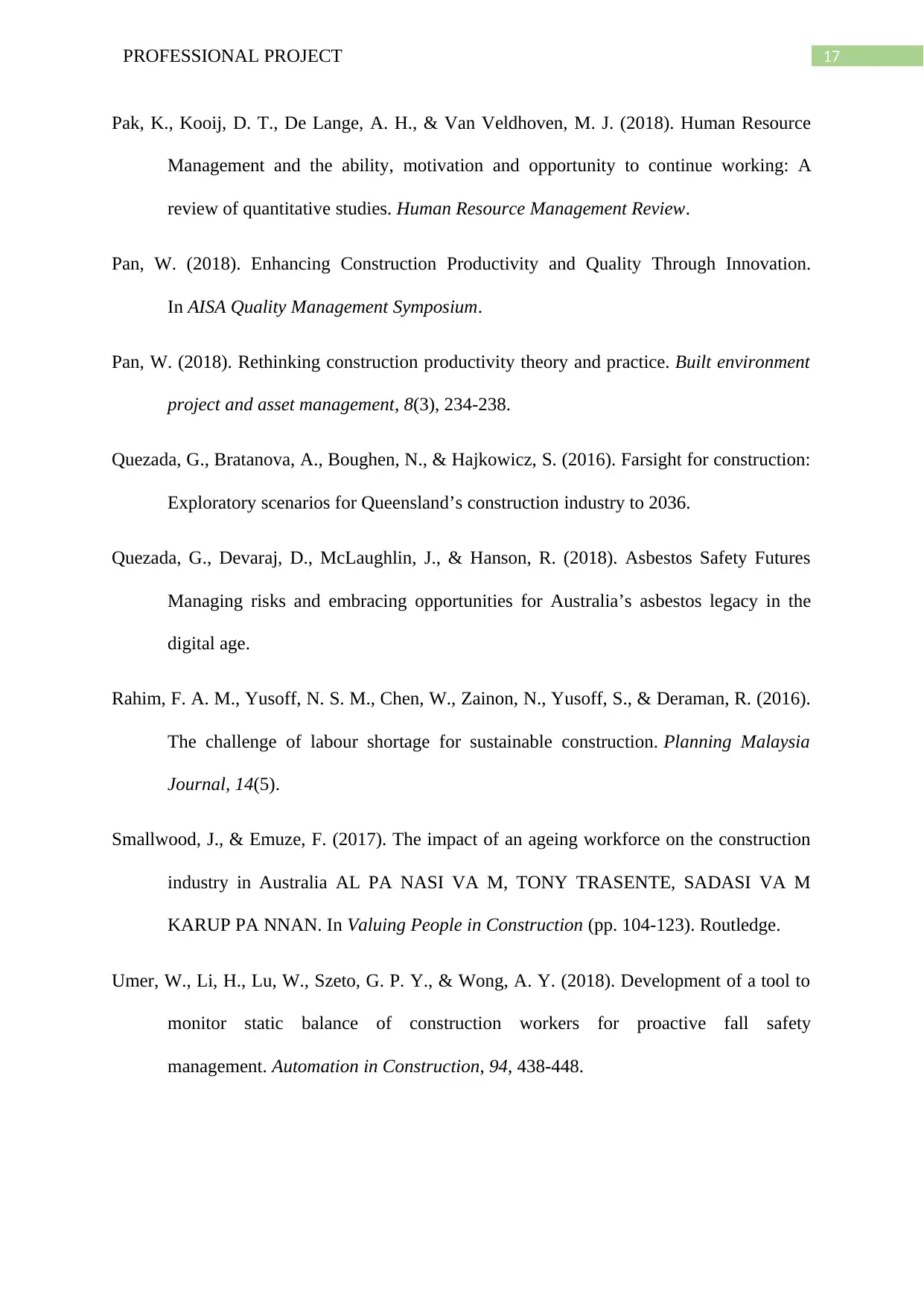
17PROFESSIONAL PROJECT
Pak, K., Kooij, D. T., De Lange, A. H., & Van Veldhoven, M. J. (2018). Human Resource
Management and the ability, motivation and opportunity to continue working: A
review of quantitative studies. Human Resource Management Review.
Pan, W. (2018). Enhancing Construction Productivity and Quality Through Innovation.
In AISA Quality Management Symposium.
Pan, W. (2018). Rethinking construction productivity theory and practice. Built environment
project and asset management, 8(3), 234-238.
Quezada, G., Bratanova, A., Boughen, N., & Hajkowicz, S. (2016). Farsight for construction:
Exploratory scenarios for Queensland’s construction industry to 2036.
Quezada, G., Devaraj, D., McLaughlin, J., & Hanson, R. (2018). Asbestos Safety Futures
Managing risks and embracing opportunities for Australia’s asbestos legacy in the
digital age.
Rahim, F. A. M., Yusoff, N. S. M., Chen, W., Zainon, N., Yusoff, S., & Deraman, R. (2016).
The challenge of labour shortage for sustainable construction. Planning Malaysia
Journal, 14(5).
Smallwood, J., & Emuze, F. (2017). The impact of an ageing workforce on the construction
industry in Australia AL PA NASI VA M, TONY TRASENTE, SADASI VA M
KARUP PA NNAN. In Valuing People in Construction (pp. 104-123). Routledge.
Umer, W., Li, H., Lu, W., Szeto, G. P. Y., & Wong, A. Y. (2018). Development of a tool to
monitor static balance of construction workers for proactive fall safety
management. Automation in Construction, 94, 438-448.
Pak, K., Kooij, D. T., De Lange, A. H., & Van Veldhoven, M. J. (2018). Human Resource
Management and the ability, motivation and opportunity to continue working: A
review of quantitative studies. Human Resource Management Review.
Pan, W. (2018). Enhancing Construction Productivity and Quality Through Innovation.
In AISA Quality Management Symposium.
Pan, W. (2018). Rethinking construction productivity theory and practice. Built environment
project and asset management, 8(3), 234-238.
Quezada, G., Bratanova, A., Boughen, N., & Hajkowicz, S. (2016). Farsight for construction:
Exploratory scenarios for Queensland’s construction industry to 2036.
Quezada, G., Devaraj, D., McLaughlin, J., & Hanson, R. (2018). Asbestos Safety Futures
Managing risks and embracing opportunities for Australia’s asbestos legacy in the
digital age.
Rahim, F. A. M., Yusoff, N. S. M., Chen, W., Zainon, N., Yusoff, S., & Deraman, R. (2016).
The challenge of labour shortage for sustainable construction. Planning Malaysia
Journal, 14(5).
Smallwood, J., & Emuze, F. (2017). The impact of an ageing workforce on the construction
industry in Australia AL PA NASI VA M, TONY TRASENTE, SADASI VA M
KARUP PA NNAN. In Valuing People in Construction (pp. 104-123). Routledge.
Umer, W., Li, H., Lu, W., Szeto, G. P. Y., & Wong, A. Y. (2018). Development of a tool to
monitor static balance of construction workers for proactive fall safety
management. Automation in Construction, 94, 438-448.
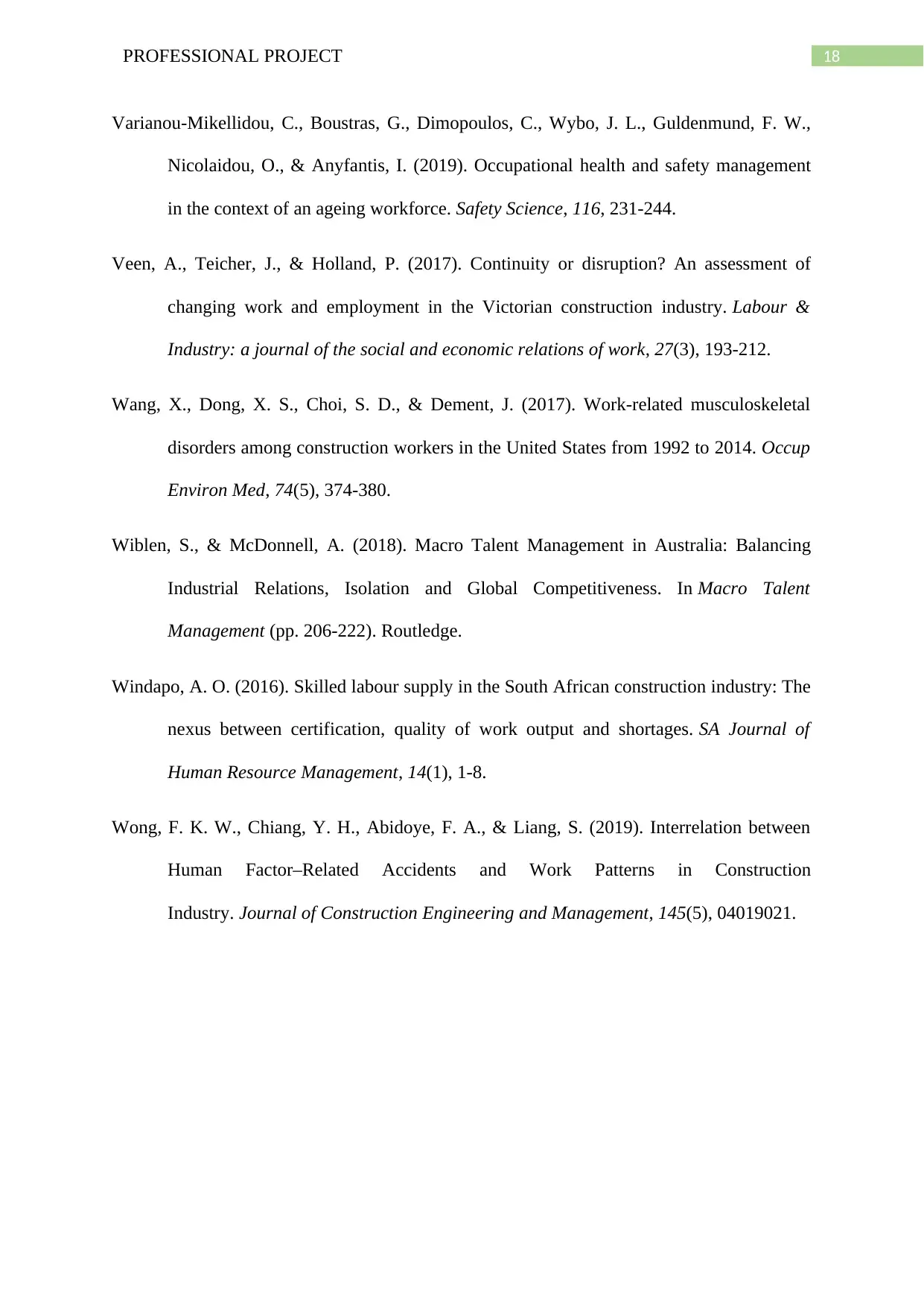
18PROFESSIONAL PROJECT
Varianou-Mikellidou, C., Boustras, G., Dimopoulos, C., Wybo, J. L., Guldenmund, F. W.,
Nicolaidou, O., & Anyfantis, I. (2019). Occupational health and safety management
in the context of an ageing workforce. Safety Science, 116, 231-244.
Veen, A., Teicher, J., & Holland, P. (2017). Continuity or disruption? An assessment of
changing work and employment in the Victorian construction industry. Labour &
Industry: a journal of the social and economic relations of work, 27(3), 193-212.
Wang, X., Dong, X. S., Choi, S. D., & Dement, J. (2017). Work-related musculoskeletal
disorders among construction workers in the United States from 1992 to 2014. Occup
Environ Med, 74(5), 374-380.
Wiblen, S., & McDonnell, A. (2018). Macro Talent Management in Australia: Balancing
Industrial Relations, Isolation and Global Competitiveness. In Macro Talent
Management (pp. 206-222). Routledge.
Windapo, A. O. (2016). Skilled labour supply in the South African construction industry: The
nexus between certification, quality of work output and shortages. SA Journal of
Human Resource Management, 14(1), 1-8.
Wong, F. K. W., Chiang, Y. H., Abidoye, F. A., & Liang, S. (2019). Interrelation between
Human Factor–Related Accidents and Work Patterns in Construction
Industry. Journal of Construction Engineering and Management, 145(5), 04019021.
Varianou-Mikellidou, C., Boustras, G., Dimopoulos, C., Wybo, J. L., Guldenmund, F. W.,
Nicolaidou, O., & Anyfantis, I. (2019). Occupational health and safety management
in the context of an ageing workforce. Safety Science, 116, 231-244.
Veen, A., Teicher, J., & Holland, P. (2017). Continuity or disruption? An assessment of
changing work and employment in the Victorian construction industry. Labour &
Industry: a journal of the social and economic relations of work, 27(3), 193-212.
Wang, X., Dong, X. S., Choi, S. D., & Dement, J. (2017). Work-related musculoskeletal
disorders among construction workers in the United States from 1992 to 2014. Occup
Environ Med, 74(5), 374-380.
Wiblen, S., & McDonnell, A. (2018). Macro Talent Management in Australia: Balancing
Industrial Relations, Isolation and Global Competitiveness. In Macro Talent
Management (pp. 206-222). Routledge.
Windapo, A. O. (2016). Skilled labour supply in the South African construction industry: The
nexus between certification, quality of work output and shortages. SA Journal of
Human Resource Management, 14(1), 1-8.
Wong, F. K. W., Chiang, Y. H., Abidoye, F. A., & Liang, S. (2019). Interrelation between
Human Factor–Related Accidents and Work Patterns in Construction
Industry. Journal of Construction Engineering and Management, 145(5), 04019021.
1 out of 19
Related Documents
Your All-in-One AI-Powered Toolkit for Academic Success.
+13062052269
info@desklib.com
Available 24*7 on WhatsApp / Email
![[object Object]](/_next/static/media/star-bottom.7253800d.svg)
Unlock your academic potential
© 2024 | Zucol Services PVT LTD | All rights reserved.





